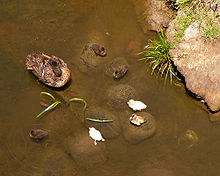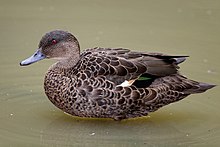Chestnut duck
| Chestnut duck | ||||||||||||
|---|---|---|---|---|---|---|---|---|---|---|---|---|

Male chestnut duck ( Anas castanea ) |
||||||||||||
| Systematics | ||||||||||||
|
||||||||||||
| Scientific name | ||||||||||||
| Anas castanea | ||||||||||||
| ( Eyton , 1838) |
The chestnut duck ( Anas castanea ) is a species of the duck family that belongs to the fauna of Australia . It is a small gudgeon duck with a high forehead and a round head. It is one of the few species of duck that can also tolerate water with high salinity and is found regularly in sea bays, estuaries, mangrove swamps, salt lakes and marshes . However, she is dependent on fresh water for drinking.
The IUCN estimates the population at 110,000 sexually mature individuals and classifies the chestnut duck as not endangered ( least concern ). In Australia, the chestnut duck is one of the game birds .
Appearance
The males of the chestnut duck reach a body length of 40 to 50 centimeters. The females are slightly smaller and between 35 and 45 centimeters long. Males weigh 700 grams, females 600 grams. The sexual dimorphism is very pronounced.
The females of the chestnut duck are, like many other duck species, relatively inconspicuous in color. With the black-brown head, which is hardly or not at all green, and the dark plumage on the chest, flanks and belly, they largely resemble those of the white-throated duck .
In the plain dress , the drake resembles the female, but not all males change to the plain dress. In the breeding plumage, on the other hand, the drake of the chestnut duck has a strong, shiny green head and neck, chest, stomach and flanks are maroon with lighter brown spots on the flanks. The upper wings are black-brown and have a green mirror on the arm wings. On the lower side, the wing is feathery gray-brown.
The downy chicks are black-brown on the upper side of the body, the belly sides are washed out yellow-brown. The face is relatively dark and is streaked with black-brown eyes and cheeks. There are small, pale straw-yellow spots on the rump sides and the wing hems. The beak and the feet are black-gray. In young birds the small plumage is identical to that of the females, but the back is gray, while in adult females it is black-gray. The arm wings of young males are black and shiny green and have a narrow, white end band. The large blankets are white. The iris is red-brown. Young females, on the other hand, have less colorful armwings. With them, the end edge of the large blankets is light brown and not white as with the young males. The iris is dark brown.
Possible confusion with other species
The males of the chestnut duck in their splendid dress are not to be confused with any other Australian duck species. However, they have a superficial resemblance to the Australian shoveler . The Australian shoveler has a blue-gray head, in front of the eye there is a white line that varies depending on the individual. This is often conspicuous and shaped like a crescent moon. The bill of the Australian shoveler is also broad at the front, the beak and forehead form a line.
The mallard has in common with the male of the chestnut duck the greenish, shiny head. However, the mallard has a white neck ring, the underside of the body is pale gray and the beak is yellow. The greatest possibility of confusion is with the Australian white-throated duck , with which chestnut ducks are often also associated. The chestnut duck's females, resting males and young birds are very similar to this duck, which is widespread in Australia. This one has a similar build and head profile. In flight, the two species can only be distinguished when visibility is particularly good. Chestnut ducks can only be distinguished by their slightly darker throat and chin. The plumage of the chestnut ducks is generally darker.
The females of the chestnut and the teal are also very similar. However, taints are rarely found in Australia. In the case of the teal duck, however, the face is markedly more contrasted.
Distribution area
The chestnut duck mainly inhabits the south-east of Australia , Tasmania and the coastal area of the Bass Strait . In Western Australia it is abundant in an area south of the Israelite Bay – Perth line. There are also individual observations from other regions of Australia. These include Cairns , Darwin and Alice Springs . Stray visitors also reach southern New Guinea and Lord Howe Island .
To hibernate , they move north to about 30 degrees south of latitude . During this time, associations of around 200 to 500 chestnut ducks can often be observed. Occasionally up to 2,000 animals can be found together.
habitat
The main distribution center of the chestnut duck is in the coastal regions of south-east and south-west Australia. It prefers to live in brackish coastal waters and in estuary areas . During the breeding season it populates widely dispersed large and small bodies of water, outside of the breeding season it prefers to gather on larger bodies of water. Swarms of up to 2,000 chestnut ducks can be observed in early summer. In their area of distribution they are often associated with the white-throated duck. The migration to the traditional breeding grounds begins in August and September.
The population of chestnut ducks is declining because the wetlands in which they occur are increasingly being altered by human intervention. Suitable freshwater habitats are increasingly restricted by drainage, increased salinity, pasture management and land consolidation in the vicinity of water bodies. The brackish water areas used by the chestnut duck are less affected by human intervention. At river mouths and sea bays, which are among the preferred habitats of this species, however, there is increasing development or intensive recreational use by humans.
Reproduction

The nests of the chestnut duck are built near the water or even above the surface of the water. She mainly uses tree hollows and also accepts nesting boxes . Nest boxes used by the chestnut duck are typically one meter above the ground or the water surface and are located in permanently water-bearing wetlands.
The reproductive biology of the chestnut duck is still insufficiently investigated. Information about clutch sizes of five to 17 eggs may be due to two or more females laying eggs in one nest. Conservative counts of clutches in which clutches with more than 13 eggs were not counted, since they are presumably the result of such a joint clutch, resulted in an average clutch size of 8.87 eggs. Eggs are usually laid in the early morning, with most eggs laid 24 hours apart. If the clutch is lost, there is additional clutch. The female breeds alone, the breeding season is given as 23 to 28 days.
Individual studies have come to different hatching rates. In a study conducted in Victoria , an average of 65 percent of eggs hatched into chicks. In another study, on the other hand, chicks hatched from 78.5 percent of the eggs. The chicks weigh an average of 27 grams when they hatch. The drake also takes part in guiding the chicks . The mortality rate is high. According to one study, 60 percent of 1,289 chicks died before they switched to their first old age dress.
Predators
Among the predators include the endemic Australian society Crow , both eggs as well as eating chicks. During the breeding phase, starlings and house sparrows occasionally colonize the nesting boxes, which can lead to the abandonment of clutches. It has been proven that the common bluetongue skink also eats chestnut duck eggs. Purple fowl and rag-duck eat chicks.
The predators of the adult chestnut duck include the marsh harrier and the peregrine falcon . Foxes eat the eggs and beat both juveniles and adult chestnut ducks.
food
Chestnut ducks eat seeds and insects, as well as shellfish and crustaceans. The latter are mainly recorded in the bank area. While swimming, be through the water or shovel. However, they spend most of their foraging at the water's edge. They mostly look for food at dawn and dusk. Presumably they also look for food at night.
Chestnut ducks as ornamental poultry
Chestnut ducks were imported to Europe from around 1870. In 1909 the zoo in London succeeded in breeding for the first time . The keeping of the ducks is considered to be unproblematic, as the birds are considered peaceful, less susceptible to disease and unproblematic in their diet. However, you need a shelter for the winter period.
supporting documents
literature
- PJ Higgins (Ed.): Handbook of Australian, New Zealand & Antarctic Birds , Volume 1, Ratites to Ducks, Oxford University Press, Oxford 1990, ISBN 0195530683
- Janet Kear (Ed.): Ducks, Geese and Swans. Oxford University Press, 2005, ISBN 0198546459 .
- Hartmut Kolbe; Die Entenvögel der Welt , Ulmer Verlag 1999, ISBN 3-8001-7442-1
Web links
- Anas castanea in the endangered Red List species the IUCN 2008. Posted by: BirdLife International, 2008. Accessed January 30 of 2009.
- Videos, photos and sound recordings about Anas castanea in the Internet Bird Collection
- BirdLife factsheet on the chestnut duck
Single receipts
- ↑ Higgins, p. 1282
- ↑ BirdLife Factsheet on Chestnut Duck , accessed April 12, 2011
- ↑ Higgins, p. 1282 and p. 1283
- ↑ Higgins, p. 1281
- ↑ Kolbe, p. 236
- ↑ Kolbe, p. 236
- ↑ Higgins, p. 1282
- ↑ Higgins, p. 1281
- ↑ Higgins, p. 1283
- ↑ Higgins, p. 1283
- ↑ Higgins, p. 1283 and p. 1284
- ↑ Higgins, p. 1282
- ↑ Higgins, p. 1282
- ↑ Higgins, p. 1285
- ↑ Higgins, p. 1286
- ↑ Higgins, p. 1286
- ↑ Higgins, p. 1286
- ↑ Higgins, p. 1286
- ^ Higgins, p. 1284





